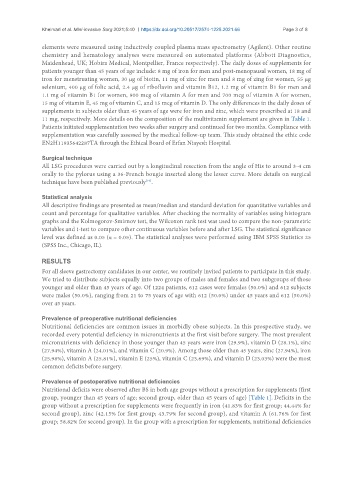Page 397 - Read Online
P. 397
Kheirvari et al. Mini-invasive Surg 2021;5:40 https://dx.doi.org/10.20517/2574-1225.2021.66 Page 3 of 8
elements were measured using inductively coupled plasma mass spectrometry (Agilent). Other routine
chemistry and hematology analyses were measured on automated platforms (Abbott Diagnostics,
Maidenhead, UK; Hobira Medical, Montpellier, France respectively). The daily doses of supplements for
patients younger than 45 years of age include: 8 mg of iron for men and post-menopausal women, 18 mg of
iron for menstruating women, 30 µg of biotin, 11 mg of zinc for men and 8 mg of zing for women, 55 µg
selenium, 400 µg of folic acid, 2.4 µg of riboflavin and vitamin B12, 1.2 mg of vitamin B1 for men and
1.1 mg of vitamin B1 for women, 900 mcg of vitamin A for men and 700 mcg of vitamin A for women,
15 mg of vitamin E, 45 mg of vitamin C, and 15 mcg of vitamin D. The only differences in the daily doses of
supplements in subjects older than 45 years of age were for iron and zinc, which were prescribed at 18 and
11 mg, respectively. More details on the composition of the multivitamin supplement are given in Table 1.
Patients initiated supplementation two weeks after surgery and continued for two months. Compliance with
supplementation was carefully assessed by the medical follow-up team. This study obtained the ethic code
EN2H11935642287TA through the Ethical Board of Erfan Niayesh Hospital.
Surgical technique
All LSG procedures were carried out by a longitudinal resection from the angle of His to around 3-4 cm
orally to the pylorus using a 36-French bougie inserted along the lesser curve. More details on surgical
[19]
technique have been published previously .
Statistical analysis
All descriptive findings are presented as mean/median and standard deviation for quantitative variables and
count and percentage for qualitative variables. After checking the normality of variables using histogram
graphs and the Kolmogorov-Smirnov test, the Wilcoxon rank test was used to compare the non-parametric
variables and t-test to compare other continuous variables before and after LSG. The statistical significance
level was defined as 0.05 (α = 0.05). The statistical analyses were performed using IBM SPSS Statistics 25
(SPSS Inc., Chicago, IL).
RESULTS
For all sleeve gastrectomy candidates in our center, we routinely invited patients to participate in this study.
We tried to distribute subjects equally into two groups of males and females and two subgroups of those
younger and older than 45 years of age. Of 1224 patients, 612 cases were females (50.0%) and 612 subjects
were males (50.0%), ranging from 21 to 75 years of age with 612 (50.0%) under 45 years and 612 (50.0%)
over 45 years.
Prevalence of preoperative nutritional deficiencies
Nutritional deficiencies are common issues in morbidly obese subjects. In this prospective study, we
recorded every potential deficiency in micronutrients at the first visit before surgery. The most prevalent
micronutrients with deficiency in those younger than 45 years were iron (29.9%), vitamin D (28.1%), zinc
(27.94%), vitamin A (24.01%), and vitamin C (20.9%). Among those older than 45 years, zinc (27.94%), iron
(25.98%), vitamin A (25.81%), vitamin E (25%), vitamin C (23.69%), and vitamin D (23.03%) were the most
common deficits before surgery.
Prevalence of postoperative nutritional deficiencies
Nutritional deficits were observed after BS in both age groups without a prescription for supplements (first
group, younger than 45 years of age; second group, older than 45 years of age) [Table 1]. Deficits in the
group without a prescription for supplements were frequently in iron (41.83% for first group; 44.44% for
second group), zinc (42.15% for first group; 43.79% for second group), and vitamin A (61.76% for first
group; 58.82% for second group). In the group with a prescription for supplements, nutritional deficiencies

